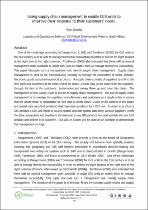 ResearchSpace
ResearchSpace
Using supply chain management to enable GIS units to improve their response to their customers' needs
JavaScript is disabled for your browser. Some features of this site may not work without it.
- ResearchSpace
- →
- Research Publications/Outputs
- →
- Conference Publications
- →
- View Item
| dc.contributor.author |
Schmitz, P

|
|
| dc.date.accessioned | 2009-02-27T14:00:31Z | |
| dc.date.available | 2009-02-27T14:00:31Z | |
| dc.date.issued | 2008-09 | |
| dc.identifier.citation | Schmitz, PMU. 2008. Using supply chain management to enable GIS units to improve their response to their customers' needs. Proceedings of the academic track of the 2008 Free and Open Source Software for Geospatial (FOSS4G) Conference incorporating the GISSA 2008 Conference, Cape Town, South Africa, September 29 - October 3, pp 8. | en |
| dc.identifier.isbn | 978-0-620-42117-1 | |
| dc.identifier.uri | http://hdl.handle.net/10204/3101 | |
| dc.description | Proceedings of the academic track of the 2008 Free and Open Source Software for Geospatial (FOSS4G) Conference incorporating the GISSA 2008 Conference, Cape Town, South Africa, September 29 - October 3, 2008 | en |
| dc.description.abstract | One of the challenges according to Dangermond (1999) and Tomlinson (2000) for GIS units in the 21st century is to be able to manage themselves successfully in order to deliver the right product at the right time to the right customer. Tomlinson (2000) also indicated that there will be several management tools available to assist GIS units to enable them to manage themselves successfully. This paper discusses such a management tool, namely supply chain management. Supply chain management is used in the manufacturing industry to manage the production of motor vehicles, electronic goods and pharmaceutical products. A supply chain consists of suppliers to a firm, the firm itself and customers at the other end of the chain. Goods flow up the chain from the suppliers, through the firm to the customers. Information and money flows up and down this chain. The management of this supply chain is known as supply chain management. The aim of supply chain management is to manage the suppliers, manufacturers and customers as a single entity to ensure that the whole chain is competitive at least cost to whole chain. Goods in the context of this paper are spatial data sets (GIS products) that have been produced by a GIS unit. In order to produce a GIS product a GIS unit needs to source spatial and non-spatial data from various suppliers, verify the data, manipulate and transform the data into a new GIS product, test and validate the new GIS product and deliver it to customer. ESI-GIS in Eskom will be used as an example to demonstrate this management concept | en |
| dc.language.iso | en | en |
| dc.subject | Supply chains | en |
| dc.subject | Supply chain management | en |
| dc.subject | GIS | en |
| dc.subject | GIS units | en |
| dc.subject | GIS products | en |
| dc.subject | Geographic information systems | en |
| dc.title | Using supply chain management to enable GIS units to improve their response to their customers' needs | en |
| dc.type | Conference Presentation | en |
| dc.identifier.apacitation | Schmitz, P. (2008). Using supply chain management to enable GIS units to improve their response to their customers' needs. http://hdl.handle.net/10204/3101 | en_ZA |
| dc.identifier.chicagocitation | Schmitz, P. "Using supply chain management to enable GIS units to improve their response to their customers' needs." (2008): http://hdl.handle.net/10204/3101 | en_ZA |
| dc.identifier.vancouvercitation | Schmitz P, Using supply chain management to enable GIS units to improve their response to their customers' needs; 2008. http://hdl.handle.net/10204/3101 . | en_ZA |
| dc.identifier.ris | TY - Conference Presentation AU - Schmitz, P AB - One of the challenges according to Dangermond (1999) and Tomlinson (2000) for GIS units in the 21st century is to be able to manage themselves successfully in order to deliver the right product at the right time to the right customer. Tomlinson (2000) also indicated that there will be several management tools available to assist GIS units to enable them to manage themselves successfully. This paper discusses such a management tool, namely supply chain management. Supply chain management is used in the manufacturing industry to manage the production of motor vehicles, electronic goods and pharmaceutical products. A supply chain consists of suppliers to a firm, the firm itself and customers at the other end of the chain. Goods flow up the chain from the suppliers, through the firm to the customers. Information and money flows up and down this chain. The management of this supply chain is known as supply chain management. The aim of supply chain management is to manage the suppliers, manufacturers and customers as a single entity to ensure that the whole chain is competitive at least cost to whole chain. Goods in the context of this paper are spatial data sets (GIS products) that have been produced by a GIS unit. In order to produce a GIS product a GIS unit needs to source spatial and non-spatial data from various suppliers, verify the data, manipulate and transform the data into a new GIS product, test and validate the new GIS product and deliver it to customer. ESI-GIS in Eskom will be used as an example to demonstrate this management concept DA - 2008-09 DB - ResearchSpace DP - CSIR KW - Supply chains KW - Supply chain management KW - GIS KW - GIS units KW - GIS products KW - Geographic information systems LK - https://researchspace.csir.co.za PY - 2008 SM - 978-0-620-42117-1 T1 - Using supply chain management to enable GIS units to improve their response to their customers' needs TI - Using supply chain management to enable GIS units to improve their response to their customers' needs UR - http://hdl.handle.net/10204/3101 ER - | en_ZA |





